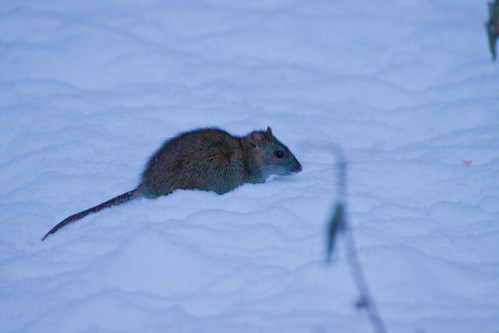Of all the rodents in the world, rats are the only one that I have a visceral dislike of—a rat is the main villain in the movie Lady and the Tramp, which originally came out in theaters in 1955, before I was old enough to go to the movies, but was re-released in 1962 when I was an impressionable 10 year old. My father was a Chicago firefighter who often told us gruesome stories about rats attacking people and eating dead bodies. When my son Joey came home with that white rat in fifth grade, the little thing’s intelligent eyes and sweet disposition instantly quelled my antipathy. When I visit my daughter in New York City, we compete to see who can spot the most rats skulking around the subway tracks and in Katie’s neighborhood—that counts as wildlife watching in the Big Apple. But still...
Rats have been associated with people for so long, and are intelligent enough to thrive even where we have spent billions trying to eradicate them, that it’s hard to imagine a large city without them. In natural habitat, particularly on islands, non-native rats and mice exact a huge toll on endangered species. Eradicating them can be done where people maintain sanitation standards and aren’t constantly augmenting their numbers via transporting grains and other foods, but virtually every rat control project involves collateral damage to humans, pets, and other wildlife, and despite our best efforts, in big cities, it’s impossible to entirely eliminate them. Katie has a dog, so we have to be extra vigilant to spot rat poison set along our walking routes before Muxy does.
Widespread as rats are, Russ and I have not had to deal with them often during our lives. Neither of us ever saw them in our blue-collar Chicago suburb as children, nor did we see them in our college towns of Urbana, Illinois; East Lansing, Michigan; or Madison, Wisconsin. I spotted one, once, in our own backyard in Duluth in the 1980s, but that was a fluke. We set out a live trap, but just caught chipmunks and never saw another rat in our neighborhood for decades. Duluth is far enough north that our cold winters have historically kept rats in check except where they can be well protected from sub-zero temperatures. Downtown Duluth has had longstanding rat problems that I learned about when I was working there back in 2005—apparently rats have a huge subterranean population living in the tunnels beneath the streets and buildings, where they can stay plenty warm. I never saw a rat downtown, but did occasionally find droppings, once even on my desk.
With climate change and an increase in composting, Duluth’s rats seem to be more able to survive outside of their sheltered downtown environment, and are spreading. A few years ago I spotted one at a friend’s feeder further east in my neighborhood. There had been a large construction project just a couple of blocks from her place, so I was hoping that was a temporary problem.
But this year, Congdon Park School, just a couple of miles west of my neighborhood, was so badly infested with rats that they had to close down the building and grounds for the entire summer. And suddenly rats started appearing right in my own neighborhood—my neighbors started seeing them fairly frequently on the other side of Peabody Street. I didn’t see any myself until just last month, when a large rat and a smaller one appeared in the back of my yard where I feed my juncos and native sparrows on the ground. The two rats scurried off to a tunnel under our neighbor’s shed. When I told my neighbors about it, they mentioned that they’d seen rats during the summer and had already trapped a couple.
I’ve always felt so lucky to live in a ratless area where I never had to worry about spreading seed on the ground during migration—that is now officially a thing of the past. And now Russ and I can’t compost until we have a chance to entirely cage in our compost bins to exclude all rodents.
With rats on the scene, I can only feed birds from elevated bird feeders, and am going to have to buy or create seed catchers too high for rats to jump into on all the poles that support my feeders, to entirely eliminate spillage.
One of my friends brought Russ and me some live traps. So far we haven’t caught a rat, which is a good thing because I’m not at all sure how we’d deal with it if we caught one. My visceral antipathy for them would be offset the moment I made eye contact. The fact that we haven’t seen or trapped any so far shows that the measures we’ve taken have at least helped. But a rat infestation on Peabody Street marks the end of my personal Age of Innocence. Too many people and a warming climate are wreaking havoc on this little planet, and attention must be paid.
